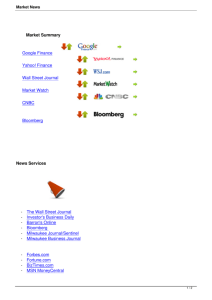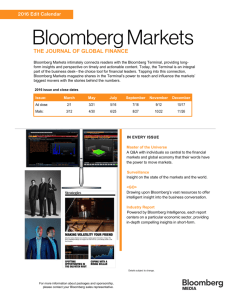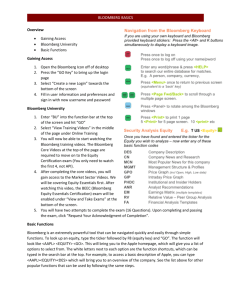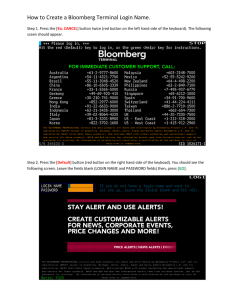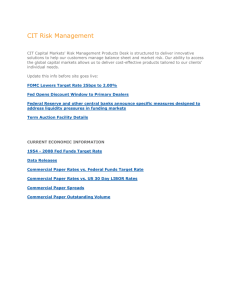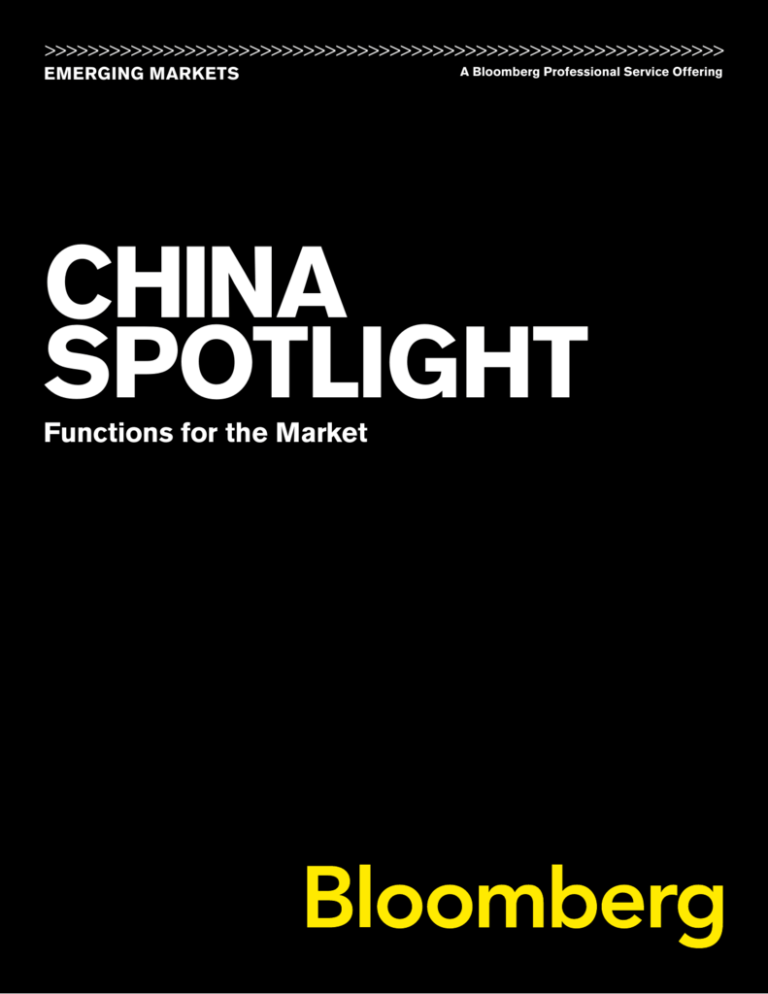
>>>>>>>>>>>>>>>>>>>>>>>>>>>>>>>>>>>>>>>>>>>>>>>>>>>>>>>>>>>>>>>
EMERGING MARKETS
A Bloomberg Professional Service Offering
CHINA
SPOTLIGHT
Functions for the Market
Contents
02 BLOOMBERG INDUSTRIES INSIGHTS
04 FIXED INCOME
07EQUITY
08 PORTFOLIO & RISK ANALYTICS
10 FOREIGN EXCHANGE
11COMMODITY
MAPPING CHINA’S
PROSPECTS
Bloomberg functions can track China’s key macro series, analyze GDP forecasts, expectations for Yuan,
and flows in Chinese stocks and Chinese bonds. Identify risk and opportunity for Chinese companies
with Bloomberg tools that track news, industry performance and market movements.
TRACKING CHINA’S DEFLATION RISK
AS YUAN SLIDES
Weak price increases in China in the second quarter of 2014
have added to concerns about deflationary pressure. Use
Bloomberg functions to get beyond the headlines, and see
how decelerating prices are influencing monetary policy and
exchange rates.
Run ECST <GO> for Bloomberg’s economic statistics dashboard and click on the ‘Custom Views’ tab (or run
ECST C <GO> as a shortcut). Open the ‘Asia Brief China
Dashboard,’ which is a curated set of the main indicators used
to track China’s growth, inflation and policy. Scroll down to the
section on ‘Inflation.’
The data shows that April’s drop in the CPI came from food
prices, with non-food prices actually accelerating slightly. That
suggests the explanation for weak price increases may be a
positive supply shock in the agricultural sector, rather than
deflation setting in.
View the Asia Brief China Dashboard
Scroll down to the section headed ‘Policy Indicators.’
The interbank seven-day repurchase rate—the main measure
of monetary conditions—fell to 3.5 percent in April from 5.3
percent in December. At first sight, it looks like Beijing is cutting
rates to boost growth. In fact, with inflation also falling, real rates
remain elevated.
Visualize that trend by highlighting ‘CPI - YoY’, which you will
find under the section headed ‘Inflation, and ‘Interbank 7 Day
Repo’ in the table, holding down the ‘Ctrl’ key while clicking on
each series. Right click and choose
‘Export to Workbench’.
Chart China’s Real Interest Rates
Within the ECWB <GO> Economic Workbench function, clear
any other series that exist in the chart by clicking the red ‘X’
icons. Then click on ‘Create Custom Series’ and choose ‘Use
Series from Current Study.’ Create a series for real interest rates
by subtracting ‘CPI—YoY’ from ‘Interbank 7D Repo,’ click ‘5)
Continue’ then on the next screen click ‘5) Finish.’ Then click
‘Actions’ in the red toolbar and save a copy of the chart. Change
the time frame above the chart to 10 years. The chart shows
that since mid-2012 real rates have been consistently positive,
Chart China’s Inflation, Exchange Rate
after a decade of real borrowing costs averaging close to zero.
That reflects the government’s attempt to end runaway lending. What impact could low inflation have on China’s exchange
rate? To see the relationship, create a new chart in ECWB.
Make this graphic more compelling by clicking on the
Add ‘CNY Curncy’ and use the ‘Add Transformation’ function
‘Edit Graph’ feature and then ‘Property Manager.’
to select ‘Year on year’. Add the China CPI YoY series
Change the names of the series to CPI, Seven-Day
‘CNCPIYOY Index’. As the chart shows, high inflation pushes
Repo Rate, and Real Interest Rates. Place all the series
the yuan to appreciate faster. Weak inflation may prolong the
on the L1 axis. Change the width of the CPI and the
Seven-Day Repo Rate series to ‘2.’ Change the
period of weakness for China’s currency.
point/bar type for the Real Interest Rates series to
Read more on NSN N5N23U6KLVR5 <GO>.
‘Vertical Bar.’ Change the chart background to ‘solid’
– Tom Orlik, May 2014
and pick a white background. Then click ‘1) Save.’
BLOOMBERG
INDUSTRIES INSIGHTS
Bloomberg Industries BI <GO> provides research, data and opinion, including an industry chat room.
Run BI CHINA <GO> to access the dedicated China page.
Developer’s Net Debt Surge Outpaces Profit Growth
Company
Guangzhou R&F Properties
2013 net
debt (CNY
BN)
37.1
Poly Property Group
20.7
YOY%
change
62.9%
NET DEBT TO EQUITY
GEARING
EnD 2013
END 2012
115.6%
86.0%
4.3%
89.6%
94.0%
Shui On Land
27.7
-0.3%
76.5%
88.2%
Greentown
19.2
42.7%
77.1%
63.7%
Shimao Property
29.8
30.0%
71.3%
63.8%
Country Garden
29.6
47.5%
67.3%
53.4%
Franshion Properties
16.6
40.6%
63.5%
52.5%
Longfor Properties
23
61.9%
62.3%
47.6%
Sino-Ocean Land
19.2
18.5%
48.0%
42.5%
China Resources Land
28.6
18.5%
43.2%
44.8%
China Vanke
32.3
67.6%
42.1%
30.2%
China Overseas Land & Investment
24.4
74.7%
28.5%
20.5%
China Merchants Property
Weighted Average
6.4
13.2%
24.0%
24.2%
314.8
29.5%
65.8%
58.7%
Source – Company filings, Bloomberg Industries
CHINA’S RECORD 2013 EARNINGS BELIES
RISING DEVELOPER RISKS
China’s record home sales in 2013 failed to generate
positive operating cash flows for any large-scale national
developer. If developers haven’t managed to do so in a
record sales year, investors may be right to wonder if
they could ever do so. Ironically, the last year that most
developers achieved positive operating cash flow was
2009, when most of them ceased land purchases due to
economic uncertainty.
The problem stems from developers’ increasing tolerance
of risk. Higher sales have been the consequence of larger
investment in working capital. This has also resulted in
higher net debt levels. Growth in industry net debt levels at
30 percent has outpaced the 19 percent increase in fiscal
year 2013 core profits.
These debts are increasingly U.S. dollar denominated even
though virtually all assets and revenues are in Chinese
yuan. Currently, the dollar has been weakening against the
yuan and the PBOC has maintained a moderately loose
monetary policy.
If these two favorable trends were to reverse in 2014,
home builders may face heightened balance sheet risks
and will probably be forced to slash prices. Home sales by
both value and volume have fallen in China’s tier 1 cities for
four straight months, the longest streak since late 2011.
For Bloomberg Industries on Asia Real Estate:
BI REALA <GO>
– Robert Fong, Bloomberg Industries, Apr 2014
China Tier 1 Home Sales Fall for Fourth Month
20%
10%
0%
-10%
-20%
-30%
-40%
-50%
Nov 13
Dec 13
Jan 14
Residential Sales Value (RMB Bn) Tier 1
Feb 14
Mar 14
Residential Sales Value Tier 1
Source – Bloomberg Industries
China Bank’s Net Interest Margins In 1Q14
1Q
3Q
1Q
1Q
2014
2013
2013
2012
Agricultural Bank of China Ltd
2.96
2.75
2.78
2.82
1Q
2012
2.97
3Q
2011
2.8
Bank of China Ltd
2.29
2.22
2.22
2.12
2.11
2.08
2.6
2.6
2.58
2.82
3.01
2.96
2.68
Bank of Communications Co. Ltd
2.53
2.57
Bank of Nanjing Co. Ltd
2.28
2.38
China CITIC Bank Corp Ltd
2.6
2.65
China Construction Bank Crop
2.81
China Merchants Bank Co Ltd
China Minsheng Banking Corp Ltd
2.62
Ping An Bank Co Ltd
2.42
2.71
2.71
2.74
2.65
2.55
2.93
2.76
3.21
2.45
2.07
2.18
CHINA BANKS CONTINUED TO SURPRISE ON
HIGHER BANK MARGINS, MORE BAD LOAN
Most Chinese banks have already reported first quarter
earnings. Five listed banks reported an average 14.7 percent
growth in net income, and most outperformed consensus
estimates. The industry continues to surprise investors
with better than expected net interest margins, belying the
problem of impending bad debt.
Aided by rising loan prices on increased default risks and high
interbank rates, three big state banks reported an average 2.7
percent margins, up 9.7 basis points from the previous quarter.
Agricultural Bank of China stood out with a 17 basis point
margin expansion, while China Construction Bank and Bank of
China reported single-digit margin widening. Minsheng Bank
posted a 17 basis point increase in net interest margins after a
45 basis point slump in 2013.
3.29
2.38
2.47
2.56
China has entered a bad-debt cycle. Five listed banks posted
an average 1 percent bad-debt ratio in the quarter versus the
0.8 percent sector average in 2013. This is worse than market
expectations. Bad-debt balances increased quickly for many
of the banks. Bank of China recorded a 10 percent increase in
bad-debt balance in the quarter, compared with the 8 percent
increase at China Merchants Bank and 6 percent rise at both
China Construction Bank and Minsheng Bank.
The market hadn’t yet formed a strong view toward the
sector. Shadow banking, local government debt and interest
rate liberalization may continue to haunt Chinese banks
through 2014.
For Bloomberg Industries on Asia Banks: BI BANKA <GO>
– Francis Wing Fu Chan, Bloomberg Industries, May 2014
EMERGING MARKETS 02 // 03
FIXED
INCOME
DISCOVERING TRADE IDEAS IN
CHINESE PROPERTY MARKET
Chinese property developer dollar bonds plunged after
the collapse of Zhejiang Xingrun Real Estate Co. Johnson
Hu, an analyst at CIMB Securities Research, predicts
more developers will go under. Use Bloomberg to analyze
comparable bonds and generate trade ideas in the Chinese
property market.
Run SRCH <GO> to bring up Bloomberg’s fixed income
search tools. Run GS <GO> to bring up the scatter plot
chart. The chart depicts bonds with similar leverage ratios
but different yield changes in one month and duration.
Modified duration measures the responsiveness of a
bond’s price to interest rate changes. As rates are expected
to go up, bonds with shorter durations are more attractive
to investors.
Running Bloomberg’s fixed income search tools
The chart can also be used as a trade idea-generation tool
for spotting relative mis-pricing among bonds that have
identical duration and leverage, but different yield change,
or identical duration and yield change but different leverage.
Read more on NSN N3OY7L6TTDSA <GO>.
– Dorothy Chan / Kai Jebens, Apr 2014
Determining bonds attractive to investors
IDENTIFYING THE NEXT FALLEN ANGELS
IN CHINA’S BOND MARKET
Following the first China onshore bond default by
Shanghai Chaori Solar Energy, Zhejiang Xingrun Real
Estate signaled difficulty in paying its creditors on March
18, prompting investors to reprice credit risk. Bloomberg
functions can help identify other Chinese bonds with
increased risk.
Run Bloomberg’s Equity Screening tool at EQS <GO> to
find distressed Chinese companies. Click on ‘33) Country
of Domicile.’ Navigate the tree through ‘Asia Pacific
(Emerging)’ and add China. Hit ‘Update’. Combining the
Bloomberg Equity Screening and Fixed Income Search
can identify a list of issuers with bonds outstanding.
Read more on NSN N2WU256TTDS0 <GO>.
– Dorothy Chan, Mar 2014
ANALYZING CHINESE BOND ISSUERS
AS FINANCING TIGHTENS
Shanghai Chaori Solar Energy announced on March
4 that it would not be able to pay its upcoming 89.8
million yuan interest payment on an outstanding 1 billion
yuan bond. On March 18, Zhejiang Xingrun Real Estate
said it was struggling to pay its debt of 3.5 billion yuan.
Bloomberg Industries and Fixed-Income Search features
suggest challenges for some Chinese companies
because of tighter refinancing conditions.
Go to BI SOLR <GO> to find Bloomberg Industry’s
special coverage of the Solar Energy industry. ‘2) Solar
Industry Liquidity Concern’ includes research on bond
defaults. Click on ‘Industry’ in the left-hand panel. Then
activate the ‘Supply/Demand’ tab. Solar power supply
in China surged in the past three years. Bloomberg’s
bond search function can find issuers in the solar energy
industry with outstanding bonds and exposure to China
to help determine whether liquidity may be a concern.
Run SRCH <GO> to find bonds that may be affected
by Chaori Solar’s recent default. Liquidity in this sector
has historically been low. Some issuers have shown an
increase in yields of their bonds while others have been
unaffected by the news.
Find special industry coverage of the solar energy market
Read more on NSN N3FPZN6KLVSB <GO>.
– Jacy He, Apr 2014
Find the Z-Spread Trends in the month
TRACKING THE RATES IMPACT OF CHINA’S
NEW CERTIFICATES OF DEPOSIT
The People’s Bank of China introduced interbank
negotiable certificates of deposit with market-based
interest rates on December 8, a milestone for Chinese
financial reform. Use Bloomberg functions to review new
NCD issuance and show that the reference Shanghai
Interbank Offered Rate is increasingly reflecting market
conditions. Visualize the change in the three-month Shibor
fixing rate by charting it against the three-month interbank
yuan deposit rate. Run G1 <GO>, select the standard
chart from the wizard and click ‘Next.’ To monitor new NCD
issues, run NIM <GO> and select the Chinese Domestic
Market from the top drop-down.
Read more on NSN MXVBA36JIJUP <GO>.
– Dorothy Chan / Don Tang, Dec 2013
Chart Shibor against the deposit rate
EMERGING MARKETS 04 // 05
FIXED
INCOME Cont.
ANALYZING CHINA’S ONSHORE BONDS
AS FOREIGN ACCESS EXPANDS
Singapore joined London and Hong Kong on October
22, 2013 as a financial center for investing in Chinese
domestic securities under the Renminbi Qualified
Foreign Institutional Investor scheme, known as RQFII.
Bloomberg functions show that China’s onshore bond
market offers higher average yields and longer times to
maturity than those of offshore securities.
Run CGB Govt DDIS <GO> and select any active
Chinese government bond to see China’s debt
distribution. To search for Chinese sovereign debt
issued offshore, run SRCH<GO>. Click ‘30) Example
Searches,’ select ‘Dim Sum Bonds (Ex CD’s)’ and then
‘1) Load Search.’Then click ‘11) Asset Classes’ and
select only ‘Governments.’
Type MOSB <GO> to monitor liquid bonds in China’s
interbank market, which accounts for the majority of the
country’s trading volume. Select ‘China’ at top left under
‘Markets,’ and ‘Latest for 2 Days’ under ‘History.’ Then
click ‘6) Chart’ to show a fitted curve using the liquid
bonds.
Read more on NSN MVK7D86K50XW <GO>.
– Stephen Zhu / Sudipto Lahiry, Nov 2013
EXAMINING CHINA BOND FUTURES AFTER
AN 18-YEAR HIATUS
On September 6, 2013, the China Financial Futures
Exchange permitted trading of bond-futures contracts for
the first time in 18 years. Bond futures allow traders to
hedge portfolio exposure and to broaden their reach to
the local markets. Bloomberg analysis can help support
this instrument.
Type “China government bond future” and select
‘TFCA Comdty’ from the autocomplete choices.
Enter DLV <GO> to find the cheapest-to-deliver (CTD)
bond for the futures contract. By default, the bonds are
sorted by implied repo rates in descending order. In the top
left drop down, change the sort order to ‘Net Basis’ from
‘Implied Repo’. To narrow the source to just the interbank
market, click on ‘97) Settings’ and next to ‘China Bond
Exch/Source’ select ‘Interbank Only.’
Bloomberg can create portfolios and help assess risk via
the Multi Asset Risk System MARS <GO>.
Read more on NSN MUSBTD6JIJUP <GO>.
– Don Tang, Oct 2013
EQUITY
Assessing IPO Performances Ahead
of Alibaba’s Record Share Sale
Alibaba Group Holdings Ltd. filed for what could become
the largest U.S. initial public offering yet. Use Bloomberg’s
Company Classification Browser to study the Chinese
company’s revenue, and Bloomberg’s Equity Offerings
dashboard to see how similar e-commerce firms have
performed since their market debuts.
To view Alibaba’s revenues, type “Alibaba” in the command
line and select the security `0983960D US Equity.’
Then run CCB <GO>. Ensure the top amber boxes are set
to ‘USD’ and ‘E-Commerce Discretionary.’ All of Alibaba’s
reported revenue of $5.49 billion was derived from
e-commerce. The table, top right, shows that e-commerce
discretionary industry sales grew by 20.04 percent in the
past year.
To see how similar e-commerce companies have performed
after going public, run IPO <GO> for the Equity Offerings
dashboard. At the top of the page, check `IPO’ and set the
currency to ‘USD.’
Read more on NSN N5SFE76S9728 <GO>.
– Kitty Lo / Amanda Too, May 2014
Backtesting Shibor-Defensive Stocks
Amid Liquidity Squeeze
Companies with defensive business models in
non-cyclical sectors are less sensitive to the sharp rise
in the Shanghai interbank offered rate, as shown in a
previous Functions for the Markets article. Bloomberg
Equity Screening function EQS <GO> can identify the
Shibor-defensive stocks within these industries and can
backtest their performance during the liquidity squeeze in
2013. For Equity Backtesting function, run EQBT <GO>.
Read more on NSN MZD3E36JTSE8 <GO>.
– Stephen Zhu / Erik But, Jan 2014
EMERGING MARKETS 06 // 07
PORTFOLIO &
RISK ANALYTICS
Optimizing Chinese stock portfolios
with quantitative methods (1/2)
The Shanghai Shenzhen CSI 300 Index remains 67 percent
below its October 2007 peak. Bloomberg’s new China A
Factor Model within the Portfolio & Risk tool helps construct
a Chinese equities portfolio that would have outperformed
the CSI 300 by 18 percentage points since the end of 2010
with lower total risk.
Set the portfolio and benchmark to CSI 300 Index.
Run PORT <GO> to access the China A Factor Model,
which is a multi-factor model based on the fundamental
characteristics of companies listed in China.
In the ‘Main View,’ click the ‘Port’ drop-down menu and
select ‘More Sources.’ In the pop-up menu, select ‘Indices’,
and type ‘CSI 300 Index’ in the amber box and use
autocomplete to add the Shanghai Shenzhen CSI 300 Index.
Click ‘1) Select.’
Set the portfolio and benchmark CSI 300 Index
Note: access to the weightings of the CSI 300 Index is
restricted to clients with permission.
To add the CSI 300 again as a benchmark, click on the
drop-down box next to ‘vs’ and repeat the steps above.
For this analysis, set the time horizon for tracking error
defaults to one year. Click ‘13) Settings,’ then ‘Calculation
Defaults.’ Under ‘Risk Defaults,’ set the time horizon to
‘1 year (252 days).’
Click ‘1) Save’ to return to the main screen. Then click ‘14)
Trade Simulation’ in the red toolbar and select ‘Launch
Optimizer’ to continue with the analysis.
Set the time horizon for tracking error defaults
Risk models available in the Portfolio Optimization tool
include the China A Factor Model, which is calibrated
to A-shares listed in China. It includes unique features,
including the use of SYWG sector classifications and the
Amihud liquidity factor. The model can be used for tracking
error and value at risk (VaR), and also for performing
scenario analysis. It also helps backtest optimization
quantitative strategies.
Under the ‘Risk Model’ drop-down at the top right, select
‘Chinese Equity Fundamental,’ which incorporates the China
A Model. (Note: The Bloomberg Risk Model (regional) also
incorporates this model, as well as distinct models for Asia
and Japan.)
In the ‘1. Goals’ section, use the pencil icon to set the first
goal to minimize ‘Portfolio Total Risk,’ using the pop-up menu
to search for the field. Then click ‘Add Goal,’ and find the
“CNA Value,” which is the China Value factor. Set this goal to
‘Maximize.’ Set the trade-off between the two goals to 1.
Set the security list under ‘2) Universes’ to ‘Current
Benchmark.’ Under ‘3) Constraints,’ add the ‘Turnover’
Setup the portfolio optimization
constraint, and set this to a maximum of 30.
Under ‘Security properties’, in order to exclude cash, set
both the ‘Min’ and ‘Max’ values to zero. Set the minimum
weight relative to the initial portfolio to minus 30 and the
maximum weight to 30, with a lot size of 1.
OPTIMIZING CHINESE STOCK PORTFOLIOS WITH
QUANTITATIVE METHODS (2/2)
Finally, click ‘1) Run’ to optimize and allow the function to
process the analysis.
The optimizer reduced the risk from 20.47 to 18.9 and
increased exposure to value from 0.02 to 0.28, suggesting
4 buys and 69 sells with turnover set at 30 percent.
To track how the optimized portfolio would have performed
historically, tick ‘Backtest Enabled’ at the top right, and set
the frequency to ‘Month End,’ starting 36 months from the
end data.
Then select ‘Save’ and click on ‘1) Run Backtest’.
A message will be sent to your Bloomberg inbox when the
backtesting is complete.
Setup the backtest
Add the portfolio back into PORT <GO> in the ‘Port’ field,
following the instructions in the first section of this article.
Set the benchmark as ‘CSI 300,’ and then select the
‘Performance’ and ‘Total Return’ tabs. Set the date range to
12/31/2010. The portfolio shows outperformance of about
18 percentage points against the CSI 300 on a total return
basis since end-December 2010.
Valuations for Chinese companies have fallen to 10 to
15 times earnings in 2013 from about 45 times earnings
in 2007, as Chinese growth expectations declined and
investor sentiment toward stocks grew negative. Valuation
levels for Chinese stocks are now similar to those of global
equities.
Adjust the backtest settings
Read more on NSN MSMG7R6JTSEU <GO>.
– Andrew Eliot / Kahfai Kok / Dorothy Chan / Erik But,
Sep 2013
For more on backtesting, see the FFM entitled
‘Backtesting Value Investing Strategies in Chinese Equities’
Read more on NSN M4TFN16KLVR6 <GO>.
Measure outperformance of the optimized portfolio
EMERGING MARKETS 08 // 09
FOREIGN
EXCHANGE
ANALYZING CHINA’S MANUFACTURING
PMI DATA FOR FX SIGNALS
Bloomberg now hosts PMI data in collaboration with Markit
to provide advance insight on the direction of fundamental
economic indicators. Bloomberg functions show the
China PMI index may help to forecast moves in the yuan.
Three years of PMI data history is available to Bloomberg
users without further subscription. For a more historical
perspective, set the date range above the chart to 3 years
in ECWB <GO>.
Read more on NSN N2QKPL6KLVR8 <GO>.
– Alison Fletcher, Mar 2014
IDENTIFYING CHINA-RELATED
FX OPPORTUNITIES
China’s policy makers said they wish to reduce foreign
exchange market intervention, expand the yuan’s trading
band and increase the currency’s flexibility. Meanwhile,
high interest rates have pushed down credit growth and
increased capital inflows. Bloomberg tools help identify
market opportunities related to these trends.
To view currency forecasts for USDCNY, run FXFC <GO>.
Select ‘2) Asia’ as the region in the top right amber field.
The first line in the list displays the median forecast for
USDCNY out to 2018. Analysts on average expect the
renminbi to continue strengthening during 2014 and out
to 2017, while the forward remains upward sloping.
China’s central bank said it will continue to seek broad
foreign exchange reform and push the twin objectives of
lower credit growth and greater interest rate liberalization.
Both require money market rates to stay at elevated levels.
With interest rates elevated, capital inflows may continue to
put upward pressure on the yuan, which means the central
bank may have to wait to make good on its promise to
cease intervention in the foreign exchange market.
If China succeeds in making currency trading more
market-driven, realized volatility may spike. Type VCA
<GO> to see current levels of implied volatility for currency
pairs relative to historical averages. Currently, implied
volatility is still lower than its historical average during the
past six months. If volatility increases, the options market
might offer an opportunity for investors. Type SDRV <GO>
to track current activity in the FX options market across
currency pairs.
Read more on NSN N0QYJQ6TTDS3 <GO>.
– Annie Grebenyuk, Feb 2014
COMMODITY
EXPLORING COPPER’S RELATIONSHIP
WITH CHINA MANUFACTURING PMI
China is the largest buyer of copper, and its industrial
production is crucial to understanding the direction of
copper prices. Bloomberg functions show the Chinese
PMI can be used for both forecasting and confirmation of
the metal’s movements.
Type “CHINA PMI” in the command line and select
‘MPMICNMA Index’ from the autocomplete. Choose
GP from the menu to generate a three-year, monthly
chart of the PMI index. Click ‘11) Compare’ and type in
“LME copper”, choosing ‘LMCADS03 Comdty’ from the
suggestions. Un-check the ‘Normalize’ box and hit Update.
Then click onto the periodicity drop-down above the chart
and select ‘Daily, 3 Years’.
For a deeper analysis of the relationship, open the
‘Security/Study’ blade and select ‘+ Add Study’ under the
copper security and type “correlation” and choose from
autocomplete. Click on the pencil next to the study and
change the security to “MPMICNMA Index” and the period
to 4. The correlation between the readings has been as
high as 93 percent.
Read more on NSN N32F4J6K50XZ <GO>.
– Guido Riolo, Mar 2014
UNCOVERING DIVERGENCES IN
COPPER SKEW AS CHINA STUTTERS
Copper prices have plummeted 9 percent so far this month
in New York and London amid concern about stuttering
Chinese demand. Bloomberg functions show that while
volatility has surged on both sides of the Atlantic, the put
skew is higher in the U.S.
Compare the evolution of copper futures in New York
and London by charting COMEX Copper active contract:
run HG1 Comdty GP <GO>. Change the quotation to
USD/Mt to compare prices with LME in the same unit.
To do so, click on ‘Security/Study’ and hit the pencil
next to ‘Last Price’ to edit the format. Change the unit
from “Local Cur” to “USD” and change the multiplier
from 1 to 2204.62 (there are 2,204.62 lbs of copper
in one metric ton–this information can be found on
HG1 Comdty UNTC <GO>) and then click on ‘Update’.
For a closer look at the volatility, run LP1 Comdty
OVDV <GO> to load the LME copper volatility surface.
Click on ‘2) 3D Surface’. Using the two drop-downs
at the top left of the chart, set the surface to show
‘Delta’ and ‘Tenors’.
Read more on NSN N2NN6S6JIJVE<GO>.
– Thibaud Gery, Mar 2014
EMERGING MARKETS 10 // 11
about THE
BLOOMBERG
PROFESSIONAL
SERVICE
The founding vision in 1982 was to create an information
services, news and media company that provides business
and financial professionals with the tools and data they need
on a single, all-inclusive platform. The success of Bloomberg
is due to the constant innovation of our products, unrivalled
dedication to customer service and the unique way in which
we constantly adapt to an ever-changing marketplace. The
Bloomberg Professional service is a powerful and flexible
tool for financial professionals–whatever their needs–in
cash and derivatives markets as diverse as equities,
currencies, commodities, money markets, government and
municipal securities, mortgages, indices, insurance and legal
information. The Bloomberg Professional service seamlessly
integrates the very best in real-time data, news and analytics.
In addition, Bloomberg users benefit from on-demand
multimedia content, extensive electronic trading capabilities
and a superior communications platform. Bloomberg
customers include influential decision makers in finance,
business and government. Business and financial
professionals recognize the Bloomberg Professional service
as the definitive tool for achieving their goals because it offers
unparalleled assistance and functionality on a single platform
for a single price.
12 // 13 EMERGING MARKETS
LEARN MORE
For more information please contact your local sales representative or press the <HELP> key twice on the
Bloomberg Professional® service. Please follow us on weibo.com/chinabloomberg and @彭博Bloomberg on LinkedIn.
>>>>>>>>>>>>>>>>>>>>>>>>>>>>>>>>>>>>>>>>>>>>>>>>>>>>>>>>>>>>>>>>>>>>>>>>>>>>>>>>>>>>>>>>>>>>>
BEIJING
+86 10 6649 7500
SHANGHAI
+86 21 6104 3000
LONDON
+44 20 7330 7500
NEW YORK
+1 212 318 2000
SÃO PAULO
+55 11 2395 9000
SYDNEY
+61 2 9777 8600
DUBAI
+971 4 364 1000
HONG KONG
+852 2977 6000
MUMBAI
+91 22 6120 3600
SAN FRANCISCO
+1 415 912 2960
SINGAPORE
+65 6212 1000
TOKYO
+81 3 3201 8900
The data included in these materials are for illustrative purposes only. ©2014 Bloomberg L.P. All rights reserved. S43525108 DIG 0614

